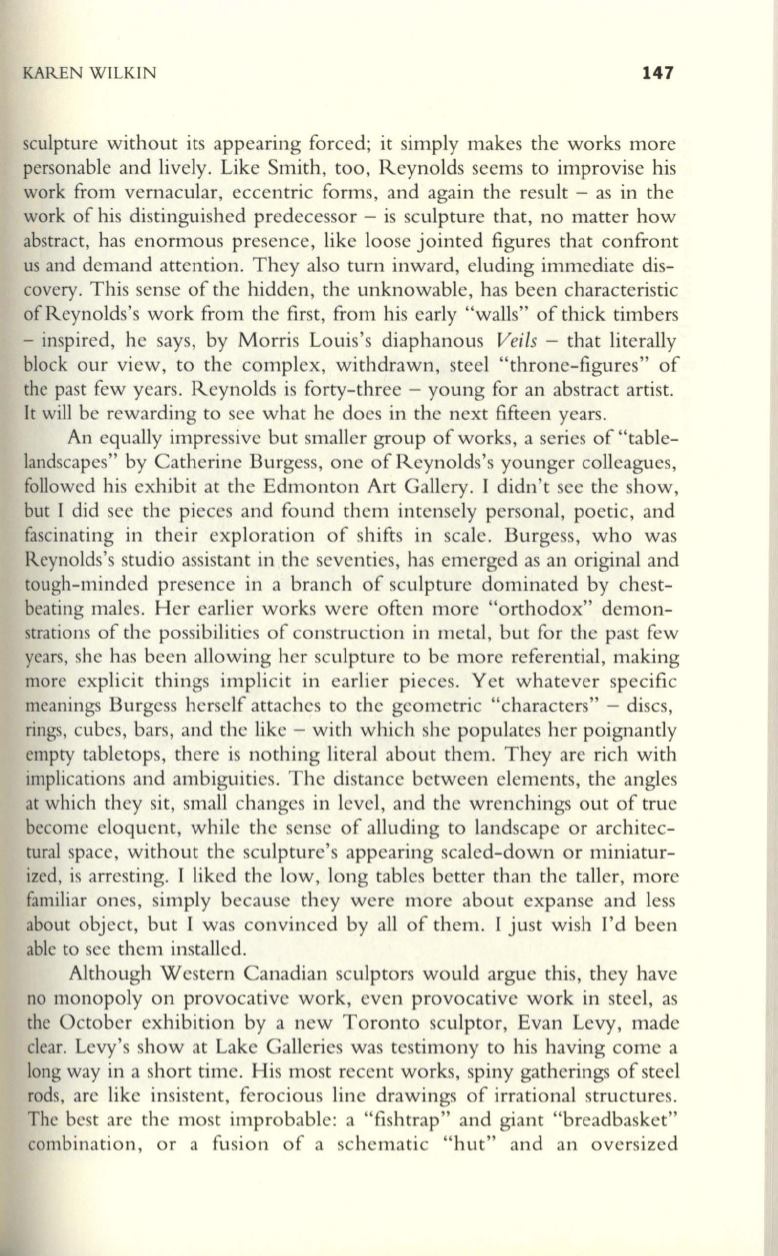
KAREN WILKIN
147
sculpture without its appearing forced; it simply makes the works more
personable and lively. Like Smith, too, Reynolds seems to improvise his
work from vernacular, eccentric forms, and again the result - as in the
work of his distinguished predecessor - is sculpture that, no matter how
abstract, has enormous presence, like loose jointed figures that confront
us and demand attention. They also turn inward, eluding immediate dis–
covery. This sense of the hidden, the unknowable, has been characteristic
of Reynolds's work from the first, from his early "walls" of thick timbers
- inspired, he says, by Morris Louis's diaphanous
Veils
-
that literally
block our view, to the complex, withdrawn, steel "throne-figures" of
the past few years . Reynolds is forty-three - young for an abstract artist.
It
will be rewarding to see what he does in the next fifteen years.
An equally impressive but smaller group of works, a series of "table–
landscapes" by Catherine Burgess, one of Reynolds's younger colleagues,
followed his exhibit at the Edmonton Art Gallery. I didn't see the show,
but I did see the pieces and found them intensely personal, poetic, and
fascinating in their exploration of shifts in scale. Burgess, who was
Reynolds's studio assistant in the seventies, has emerged as an original and
tough-minded presence in a branch of sculpture dominated by chest–
beating males. Her earlier works were often more "orthodox" demon–
strations of the possibilities of construction in metal, but for the past few
years, she has been allowing her sculpture to be more referential, making
more explicit things implicit in earlier pieces. Yet whatever specific
meanings Burgess herself attaches to the geometric "characters" - discs,
rings, cubes, bars, and the like - with which she populates her poignantly
empty tabletops, there is nothing literal about them. They are rich with
implications and ambiguities. The distance between elements, the angles
at which they sit, small changes in level, and the wrenchings out of true
become eloquent, while the sense of alluding to landscape or architec–
tural space, without the sculpture's appearing scaled-down or miniatur–
ized, is arresting. I liked the low, long tables better than the taller, more
familiar ones, simply because they were more about expanse and less
about object, but I was convinced by all of them. I just wish I'd been
able to see them installed.
Although Western Canadian sculptors would argue this, they have
no monopoly on provocative work, even provocative work in steel, as
the October exhibition by a new Toronto sculptor, Evan Levy, made
clear. Levy's show at Lake Galleries was testimony to his having come a
long way in a short time. His most recent works, spiny gatherings of steel
rods, are like insistent, ferocious line drawings of irrational structures .
The best are the most improbable: a "fishtrap" and giant "breadbasket"
combination, or a fusion of a schematic "hut" and an oversized


